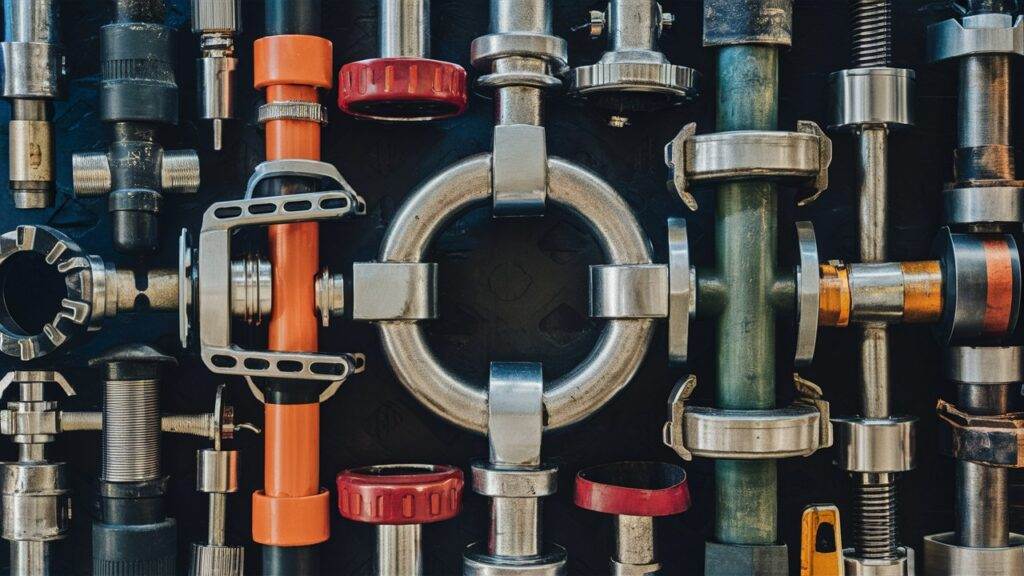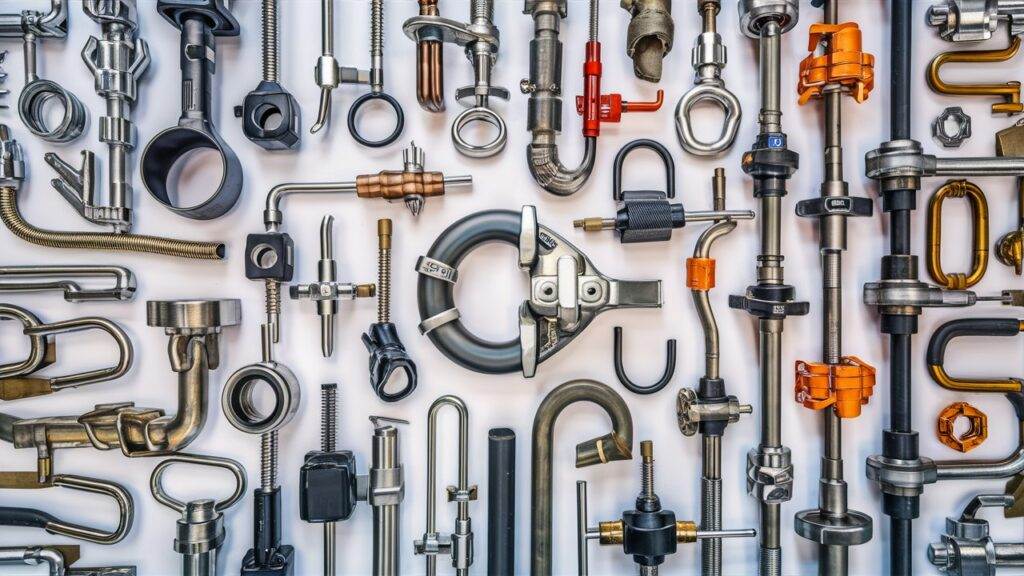Selecting the right exhaust clamp ensures durability and efficiency in your automotive exhaust system. Understand different types like U-Bolt Clamps, V-Band Clamps, and Pipe Clamps to find the best one for your needs.
Types of Exhaust Clamps- Choosing the Right Clamp for Your Application
Challenge- Selecting the Right Clamp for the Job
Choosing the right exhaust clamp is super important for your vehicle’s exhaust system. If you pick the wrong one, it can cause leaks or misalignment. These problems can hurt your car’s performance and even lower fuel efficiency. So, it’s really smart to know what your exhaust system needs before making a choice.
Here are some common issues that can happen if you don’t select the right clamp:
- Increased Emissions: Leaks can let harmful gases escape into the air.
- Noise Issues: Loose connections might create rattling sounds or loud noises.
- Potential Damage: If parts aren’t secured well, they could damage other parts of the exhaust system.
To avoid these issues, take some time to think about what your vehicle needs. Talking to automotive experts can also help you make a better decision.
Exhaust Clamps and Their Importance
Exhaust clamps are special fasteners made to hold different parts of an automotive exhaust system together. Their main job is to create a tight seal between pipes so that no leaks happen.
These clamps do more than just hold things in place; they help keep the entire exhaust system working well. A properly secured system reduces vibrations and helps exhaust gases flow smoothly. This is good for your vehicle’s performance!
What Exhaust Parts are Used in an Exhaust System?
An automotive exhaust system has several key components, each with its own role:
- Exhaust Pipes: They carry gases from the engine out of the vehicle.
- Mufflers: Mufflers help lessen noise made by the engine.
- Catalytic Converters: These change harmful gases into less harmful ones before they exit through the tailpipe.
- Exhaust Hangers: They support various parts of the exhaust system and keep everything secure.
Knowing what each part does is important when picking clamps that will provide proper support and sealing throughout your vehicle’s exhaust system.
Recent Advancements in Exhaust Clamps
There have been some cool advancements in how exhaust clamps are made lately. New designs and materials have improved their durability a lot! For example, some clamps now have coatings that resist rust and materials that can handle high heat better.
Manufacturers are focusing on creating lightweight yet strong clamps that seal better without losing strength. These improvements not only boost performance but also make both the clamp and overall exhaust systems last longer.
In short, picking out the right type of exhaust clamp means understanding what your vehicle needs while also considering new tech that makes them work better and last longer! By keeping these things in mind, you can help ensure your car’s exhaust system runs great!
Different Types of Exhaust Clamps
U-Bolt Clamps
U-Bolt Clamps are super popular in cars and trucks because they are easy to use and work really well. These clamps have a U-shaped bolt that goes around the exhaust pipe and is held tight with nuts. They keep the pipes from moving, which is really important.
Features and Benefits:
- Durability: U-Bolt Clamps last a long time and don’t wear out easily.
- Easy to Install: You can put them on quickly without any fuss.
- Versatile: They fit different pipe sizes, so you can use them in many types of exhaust systems.
- Leak Prevention: They create a tight seal that stops exhaust leaks, which helps your vehicle run better.
Common Applications:
You’ll find U-Bolt Clamps in regular exhaust systems, truck parts, and even custom setups where you need some flexibility.
Pros and Cons:
They’re great for quick installation and don’t cost much. But sometimes they might not hold as tightly as other clamps when under a lot of pressure.
V-Band Clamps
V-Band Clamps are a favorite for high-performance cars because they let you take things apart quickly without losing the seal.
Advantages:
- Leak-Free Connection: These clamps keep everything sealed tight even when things get hot.
- Perfect for Turbo Applications: They work well with turbochargers and racecars where reliability is key.
Installation Process:
To use V-Band Clamps, just fit two flanges together with the clamp around them. This keeps everything secure but lets you take it apart easily when needed.
Scenarios Where V-Band Clamps Excel:
These clamps shine in situations where you need to take things apart often, like custom exhausts or upgrades for performance.
T-Bolt Clamps
T-Bolt Clamps have a T-shaped bolt that gives more clamping power than regular hose clamps.
Increased Security:
They’re built to handle higher pressures really well, making them good for both cars and industrial uses where strength matters.
Ideal Uses:
You’ll see T-Bolt Clamps used in turbocharger setups or anywhere that needs extra grip against shaking or vibrations.
Comparison with Other Types:
When compared to standard hose clamps or U-Bolts, T-Bolts hold tighter but might need more careful installation.
Marmon Clamps
Marmon Clamps use a special flare design that makes strong connections between pipes.
Unique Features:
These make it easy to put together or take apart without harming the pipes. This is especially handy for big trucks where getting to parts can be tricky.
Applications:
You’ll find Marmon connections mostly in commercial vehicles because they work well under tough conditions.
Band Clamps
Band Clamps are flexible since they can adjust to different sizes using strong straps made from materials like stainless steel.
Flexibility and Versatility:
They can be used in many situations from regular cars to custom builds that involve flexible tubing.
Saddle Clamps
Saddle Clamps have an arch shape that holds the pipe snugly while keeping it stable against shakes from the engine.
Characteristics:
These clamps do a great job at holding pipes firmly without causing any damage over time thanks to their soft but strong grip on materials.
Narrow Band Clamps
Narrow Band Clamps are made for smaller pipes or tight spots in an exhaust system.
Benefits of Use:
Their small size makes them perfect for places where bigger clamps won’t fit while still sealing leaks effectively.
Tube Band Clamps
Tube Band Clamps help connect sections of tubing securely while allowing some wiggle room during installation or adjustments.
Design Specifics:
Usually made from stainless steel or other tough materials, these bands wrap tightly around tubes so there’s hardly any leakage at joints.

Factors Influencing Exhaust Clamp Selection
Material Considerations
When picking exhaust clamps, the material matters a lot. Stainless steel clamps are often the top choice because they resist corrosion and last a long time. They’re perfect for places with lots of moisture or road salt. Other materials might not hold up as well against rust and wear. For example, while premium steel clamps are strong, they might not be as good at fighting off corrosion in tough conditions. If you’re into high-performance applications, you might need special materials that can handle really high temperatures.
Size and Fitment
Getting the right size clamp is super important for a secure fit on your exhaust system parts. A clamp that’s too loose can cause exhaust leaks, while one that’s too tight can hurt the pipes. To find the right size for different pipe diameters, follow these steps:
- Measure your exhaust pipe diameter carefully.
- Use calipers or a measuring tape to get it just right.
- Make sure it matches any exhaust pipe couplings you plan to use.
This way, you’ll have a good seal and reduce problems like backpressure that can mess with how your vehicle runs.
Environmental and Lifestyle Factors
The place where you drive plays a big role in what kind of clamps you should choose. If your vehicle often drives through rough areas or extreme weather, you’ll want tougher clamps that can take more stress and resist corrosion better.
- For vehicles driven in wet or salty conditions, stainless steel clamps are best.
- Knowing how you use your vehicle—like if you take short trips often versus long highway drives—helps in choosing the right clamp type.
For instance, if you’re out driving in heavy rain or snow a lot, spending extra on quality clamps will pay off over time.
Cost vs. Quality
Finding a balance between cost and quality when choosing exhaust clamps can be tricky. It’s tempting to go for cheaper options at first, but investing in better-quality clamps could save money later by cutting down on repairs and extending how long your exhaust system parts last.
Keep these points in mind:
- Better-quality clamps usually last longer.
- Cheaper options may lead to needing replacements more often.
- A strong clamp helps prevent costly leaks or failures later on.
Thinking about both immediate costs and future savings is key when deciding what your exhaust system needs.
Common Diagnostic Tools and Tests
Checking your exhaust clamps regularly is important for keeping everything running smoothly. Look out for signs of wear like rust or bending; these could mean it’s time to replace them before bigger issues arise.
Some handy tools include:
- Torque wrenches: They help make sure the installation tension on the clamps is just right.
- Visual inspection tools: Things like mirrors or borescopes let you check hard-to-see spots inside the exhaust system.
By checking your exhaust clamps with these tools regularly, you can catch problems early and keep everything working well throughout your vehicle’s life cycle. Following these factors will help you pick the best exhaust clamps suited for your vehicle’s needs while boosting performance and reliability.

Installation and Maintenance Tips
DIY Exhaust System Building
Building your own exhaust system can be a fun project that boosts your vehicle’s performance. To kick things off, you’ll need some essential tools:
- Exhaust pipe cutter: This helps make clean cuts on pipes.
- Pipe expanders: These adjust pipe sizes for a snug fit.
- Clamps: They are key for securing connections.
Planning Your Layout
Before you start cutting any pipes, take a moment to plan how your exhaust system will look. This step is important for ensuring good airflow and proper fit. Using mandrel bent pipes can help as they allow smoother transitions and reduce backpressure.
Cutting and Fitting
When you’re ready to cut the pipes, make sure to measure accurately so everything lines up correctly. After cutting, use fittings like muffler clamps or adjustable clamps to secure the connections tightly. Choosing stainless steel parts can improve durability and help prevent rust.
Welding Tips for Exhaust Systems
Welding may be needed when you’re building or fixing an exhaust system. Here are some helpful tips:
- Safety First: Always wear protective gear like gloves and goggles. Make sure your workspace is well-ventilated to avoid breathing in harmful fumes.
- Clean Surfaces: Before welding, clean the surfaces well to get a strong bond.
- Welding Techniques: Use TIG (Tungsten Inert Gas) or MIG (Metal Inert Gas) welding methods for the best results. Keep an eye on heat settings; too much heat can warp metal, while too little might not create a strong joint.
Maintaining Your Exhaust Clamps
Regularly checking your exhaust clamps is vital for keeping your exhaust system running well. Here’s how you can maintain them:
- Schedule inspections every few months to look for signs of wear like rust or cracks.
- If you see any damage in the clamp’s structure or if there are leaks around connections, it’s time to replace them.
Using corrosion-resistant materials such as stainless steel clamps can greatly enhance durability against environmental factors.

